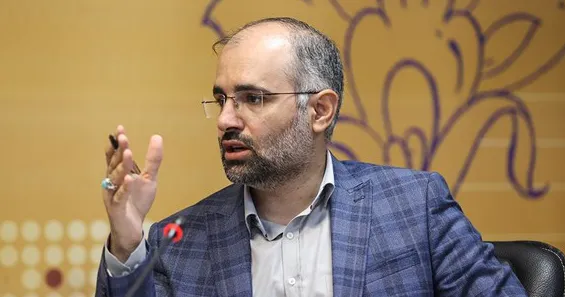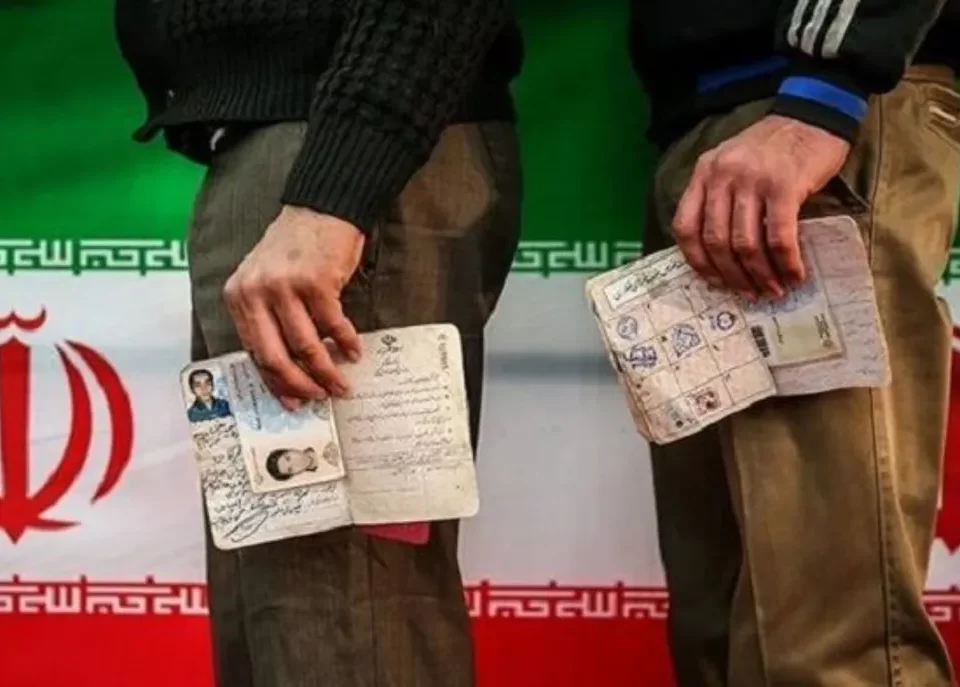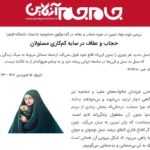
Media Review: Jomjom and the Imposition of Monotony with Fake Information and Stereotypes
May 7, 2023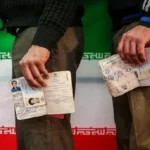
Media Review: What is the Way to Protect Yourself and Others Against the Dangerous Fars News Agency?
May 7, 2023Clichés have always been part of media culture because they serve as signs through which individuals recognize and relate to phenomena. Writers, filmmakers, and storytellers often use clichés to meet the expectations of readers or viewers, enhance attractiveness, and capture the audience’s attention. Over the past four decades, the government has utilized the technique of producing clichés to shape public opinion and create constructed clichés that can legitimize oppression.
“Monarchists,” “hypocrites,” “Baha’is,” “agitators,” and “foreign agents” are coded terms for suppression. The use of these clichés by the leaders of the Islamic Republic does not indicate any concrete reality but rather serves as signs to justify repression. It has become a tactic that has transformed into a behavioral pattern of the government. When such attributes are associated with the names of individuals or protesting groups, it signifies an authorized confrontation and an invitation for the initiation of violence.
To clarify the issue, please refer to the following report published by Javan Newspaper on October 12, 2022, titled “British Spy Directing Protests Up Close!”:
Media Review: Javan Newspaper and the Reproduction of “Suppression Clichés” by the Government According to a reliable source provided to “Javan,” “Stephanie Elqagh,” the Middle East Director at the British Foreign Ministry, entered the country a few days before the start of the turmoil and managed the course of protests in Iran up close. When Elqagh’s actions, meetings, and previous plans are reviewed, her presence prior to the October protests dispels all doubts regarding the guided nature of recent unrest.
Elqagh had only one conversation with Zionist authorities three months ago about Iran. The significant presence of a foreign enemy in the protests, using the pretext of Mahsa Amini’s death, is not limited to the English guidance of the October unrest in Iran. The detailed statement of the Ministry of Intelligence about the October protests revealed many hidden angles that, with the exposure of other puzzle pieces of the turmoil, provide a better understanding of its dimensions.
The connection between Baha’is and monarchists with Europeans for looting the lives and properties of Iranians was mentioned in a section of the Ministry of Intelligence’s statement about recent events. According to the statement, the Baha’i espionage organization, under the central command stationed in Haifa, had a significant presence in the scene of turmoil, inciting and encouraging acts of vandalism and destruction of public places. Based on this, in recent days, the core group and media team of the Baha’is, including three leaders of the Baha’i community and two members of their media team, have been arrested. In addition to this, 92 affiliates of the despised Pahlavi regime and marked monarchists were identified and arrested in the scenes and behind the scenes of the unrest, and 9 foreign nationals from Germany, Poland, Italy, France, the Netherlands, and Sweden were also arrested at the scenes of the protests or in the background of the conspiracy.
In conclusion, this newspaper drew the following conclusion:
“With certainty, it can be stated that while Western countries call their own citizens ‘hostages’ in Iran, they themselves have been planning for unrest in Iran for a long time and had already sent their security personnel and disruptive elements to Iran before the start of the protests.”
This report is an example of a fake and fabricated news report because:
It does not provide any valid facts to support the claims made in the report; it refers to fake sources and uses the fabricated statement of an “informed source”; Javan newspaper, affiliated with the propaganda apparatus and lacking media credibility, has published the report, and the identity of the author of the published report is unknown; the purpose of the report is to legitimize the suppression of protesters, not an attempt to uncover the truth.
However, this report employs two techniques, “appeal to clichés” and “conspiracy theory,” to deceive public opinion, which is noteworthy.
Instead of being substantiated with valid facts and data, this report relies on government-created clichés, which are commonly used to prescribe suppression.
Linking popular protests to monarchists, hypocrites, Baha’is, Israel, and the United States is not a new phenomenon. The Islamic Republic government has used these titles so much that they have turned them into “suppression clichés.” Denying the popular nature of the protests, denying the weaknesses and inefficiencies of the government system, denying the desires and demands of the people, and attributing the protests to external factors are the government’s behavioral model and pattern in the face of any criticism and opposition.
Therefore, it can explicitly be considered an example of “disinformation” because it is clear that the fabricated information contained in this report can be evaluated intentionally and with the aim of legitimizing suppression and perpetuating a harmful behavioral pattern.
Linking popular protests to “foreign hands” in this report is, in fact, resorting to “conspiracy theory” to facilitate the suppression of protests. Conspiracy theories usually have little basis in true news. The proponents of conspiracy theories only take a corner of the truth and expand it in such a way that it becomes an imaginary and delusional summary.
What can be a fragment of truth in this report is the trip of Stephanie Elcock, the Middle East director at the British Foreign Office, to Iran, Israel, and other countries as part of her job description as a member of the Foreign Office. Furthermore, Stephanie Elcock is a member of the UK’s nuclear negotiation team, and it is natural for her to have direct contact with the parties involved in this case.
The author of the Javan newspaper report, without providing any evidence or documentation, merely evaluates Stephanie Elcock’s trip to Iran and Israel as her overt attempt to directly organize the protests and introduces her as a “spy,” while this claim is fundamentally an accusation and contrary to the ethics and principles of journalism.
“Refusal to make accusations” is an important principle in media ethics that has not been observed in this report. The determination of espionage charges is not within the scope of media work but rather part of the mission of intelligence and judicial agencies.
Contrary to gender clichés rooted in our thoughts and behaviors, which have become institutionalized over time and have been accepted by the people, “suppression clichés” lack cultural backing and have little acceptance in society. Nevertheless, it can be reminded that the way to counter these clichés, conspiracy theories, and fake news is through “critical thinking” and refraining from republishing or sharing them with others, so that this destructive cycle can be stopped.
With this report, Javan newspaper hides the truth, denies the people, and strives to legitimize the suppression of protesters. Therefore, Javan newspaper can be considered a harmful and dangerous media outlet. A media outlet that serves the propaganda apparatus and stands against the people.
مرور رسانهها؛ روزنامه جوان و بازنشر «کلیشههای سرکوب» حکومت
کلیشهها همواره بخشی از فرهنگ رسانهها بودهاند، چراکه افراد جامعه پدیدهها را با این نشانهها میشناسند و با آن ارتباط میگیرند. معمولا نویسندگان، فیلمسازان و قصهگوها برای برآورده ساختن انتظارات خواننده یا بیننده، و افزایش جذابیت و جلب توجه مخاطب، از کلیشهها استفاده میکنند. حکومت نیز طی ۴ دهه گذشته، از تکنیک تولید کلیشه برای شکلدهی به افکار عمومی استفاده کرده و کلیشههایی ساخته، تا با توسل به آن بتواند به سرکوب مشروعیت ببخشند.
***
«سلطنتطلبان»، «منافقین»، «فرقه بهاییت»، «اغتشاشگران» و «عوامل خارجی» اسم رمز سرکوب است. استفاده از این کلیشهها توسط رهبران جمهوری اسلامی نه از حقیقتی ملموس، بلکه از نشانههایی برای تجویز سرکوب حکایت دارد. استفاده از تاکتیکی که به مدل و الگوی رفتاری حکومت تبدیل شده است. وقتی در کنار نام افراد، یا گروههای معترض چنین صفتهایی مینشیند، یعنی برخورد قهری مجاز و فراخوانی است برای به صحنه آمدن آتش به اختیاران.
برای روشنتر شدن مساله، لطفا به این گزارش روزنامه جوان که در روز ۲۰مهر۱۴۰۱، با عنوان «جاسوسه انگلیس از نزدیک اغتشاشات را هدایت کرد!» منتشر شده، نگاه کنید:
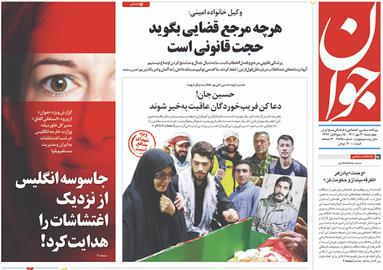
در این گزارش آمده:
بنا بر خبری که یک منبع آگاه به «جوان» ارائه کردهاست، «استفانی القاق»، مدیرکل خاورمیانه در وزارت خارجه انگلیس، چند روز پیش از آغاز آشوبها وارد کشور شده و از نزدیک روند اغتشاشات را در ایران مدیریت کردهاست. وقتی اقدامات، دیدارها و برنامهریزیهای قبلی القاق هم مرور میشود، حضور وی پیش از آغاز اغتشاشات مهرماه در ایران، همه شبهههای هدایتشده بودن اغتشاشات اخیر را میزداید.
القاق فقط در یک مورد، سه ماه پیش با مقامات صهیونیستی راجع به ایران گفتوگو کردهاست. حضور پررنگ دشمن خارجی در اغتشاشات به بهانه فوت مهسا امینی، فقط محدود به هدایت انگلیسی پروژه آشوب مهرماه در ایران نیست. بیانیه تفصیلی وزارت اطلاعات پیرامون اغتشاشات مهرماه، زوایای پنهان زیادی را آشکار کرد، که حالا و با جور شدن سایر تکههای پازل آشوب، بهتر میتوان ابعاد آن را دریافت.
پیوند بهاییت با سلطنتطلبان و اروپاییها برای غارت جان و مال ایرانیان، در بخشی از بیانیه وزارت اطلاعات پیرامون ماجراهای اخیر، به عوامل آشوبساز با ذکر جزییات اشاره شده بود. بنا بر آنچه در این بیانیه آمدهاست، سازمان جاسوسی بهاییت، بنا به دستور مرکزیت مستقر در حیفای اشغالی، ورود پرحجمی به صحنه آشوب و اغتشاش و تشویق به خرابکاری و تخریب اماکن عمومی داشت. بر این مبنا در روزهای اخیر، هسته اصلی و سری بهاییت، شامل سه نفر از سران بهاییت و دو نفر از تیم رسانهای آنها بازداشت شدند. علاوه بر این، ۹۲ نفر از وابستگان رژیم منحوس پهلوی و از سلطنتطلبان نشاندار در صحنههای اغتشاش و پشت صحنهها شناسایی و بازداشت شدند و ۹ تبعه بیگانه از اتباع آلمان، لهستان، ایتالیا، فرانسه، هلند و سوئد هم در صحنه اغتشاشات، یا در پشت صحنههای توطئه بازداشت شدند.»
این روزنامه در انتها نتیجه گرفته:
«با قاطعیت میتوان اظهارنظر کرد، اگرچه کشورهای غربی اتباع خودشان را از ایران فرامیخوانند، ولی همین کشورها از مدتها پیش برای آشوب در ایران برنامه داشتند و اتباع امنیتی و عناصر آشوبگر خود را هم پیش از آغاز اغتشاشات به ایران فرستاده بودند.»
این گزارش نمونه یک گزارش جعلی و فیک نیوز است، چراکه:
برای ادعاهای مطرح در گزارش، حتی یک فکت معتبر ارائه نمیکند؛به منابع جعلی ارجاع شده و از گزاره جعلی «یک منبع آگاه» استفاده کرده است؛روزنامه جوان، وابسته به دستگاه پروپاگاندا و فاقد اعتبار رسانهای است؛نویسنده گزارش منتشره معلوم نیست کیست؛هدف گزارش مشروعیت بخشی به سرکوب معترضان است، نه تلاشی برای کشف حقیقت؛
با این حال، این گزارش از دو تکنیک «توسل به کلیشه» و «تئوری توطئه» برای گمراه کردن افکار عمومی استفاده کرده که قابل تامل است.
این گزارش بیش از آنکه با فکتها و دیتاهای معتبر مستندسازی شده باشد، به کلیشههای ساخته حکومت متوسل شده، که معمولا برای تجویز سرکوب استفاده میشود.
ارتباط دادن اعتراضات مردمی به سلطنتطلبان، منافقین، بهاییان، اسراییل و آمریکا، پدیده تازهای نیست. حکومت جمهوری اسلامی آنقدر از این عناوین استفاده کرده که آنها را به «کلیشههای سرکوب» تبدیل کرده است. انکار مردمی بودن اعتراضات، انکار ضعفها و ناکارآمدیهای سیستم حکومتی، انکار خواستها و مطالبات مردم و … و نسبت دادن اعتراضات به بیرون، مدل و الگوی رفتاری حکومت در مواجهه با هرگونه انتقاد و مخالفت است.
بنابراین، به صراحت میتوان این گزارش را مصداق «دیس اینفورمیشن» دانست. چون روشن است که اطلاعات جعلی مندرج در این گزارش را میتوان، عامدانه و با هدف مشروعیتبخشی به سرکوب و تداوم یک الگوی رفتاری مضر ارزیابی کرد.
ارتباط دادن اعتراضات مردمی به «دست خارجی» در این گزارش نیز، در واقع توسل یافتن به «تئوری توطئه» برای تسهیل سرکوب اعتراضات است. تئوری توطئه معمولا ردی در اخبار درست دارد. طراحان تئوری توطئه، تنها گوشهای از حقیقت را میگیرند و آن را چنان بسط میدهند که به یک جمعبندی خیالی و توهمآمیز میرسند.
آنچه در این گزارش میتواند تکهای از حقیقت باشد، سفر خانم استفانی القاق، مدیرکل خاورمیانه در وزارت خارجه انگلیس به ایران، اسراییل و سایر کشورها، به عنوان بخشی از شرح شغلی یک عضو وزارت امور خارجه است. ضمن اینکه خانم استفانی القاق، عضوی از تیم مذاکره کننده هستهای انگلستان است و طبیعی است که با طرفهای درگیر در این پرونده، مستقیما در تماس باشد.
نویسنده گزارش روزنامه جوان، بدون ارائه هرگونه سند و مدرکی، تنها سفر خانم استفانی القاق به ایران و اسراییل را، تلاش آشکار او برای ساماندهی مستقیم اعتراضات ارزیابی کرده و او را «جاسوسه» معرفی میکند، حال آنکه اساسا این ادعا، یک اتهام و مغایر با اخلاق و اصول روزنامهنگاری است.
«پرهیز از اتهامزنی»، اصلی مهم در اخلاق رسانهای است که در این گزارش رعایت نشده است. تشخیص اتهام جاسوسی نه در حیطه کار رسانهای، بلکه بخشی از ماموریت دستگاههای اطلاعاتی و قضایی است.
برخلاف کلیشههای جنسیتی که ریشه در افکار و رفتار ما دارد، و به مرور زمان در میان افراد جامعه نهادینه شده و مردم با آن خو گرفتهاند، «کلیشههای سرکوب» فاقد پشتوانه فرهنگی است و پذیرش چندانی در جامعه ندارند. با این وجود، میتوان یادآوری کرد که راه مقابله با این کلیشهها و تئوری توطئه و اخبار جعلی، «تفکر انتقادی» و پرهیز از بازنشر یا به اشتراک گذاشتن آن با دیگران است، تا این چرخه مخرب متوقف شود.
روزنامه جوان با این گزارش «دایی جان ناپلئونی» حقیقت را پنهان، مردم را انکار و میکوشد به سرکوب معترضان مشروعیت ببخشد. لذا میتوان روزنامه جوان را رسانهای مضر و خطرناک خواند. رسانهای که در خدمت دستگاه پروپاگاندا و روبروی مردم ایستاده است.



